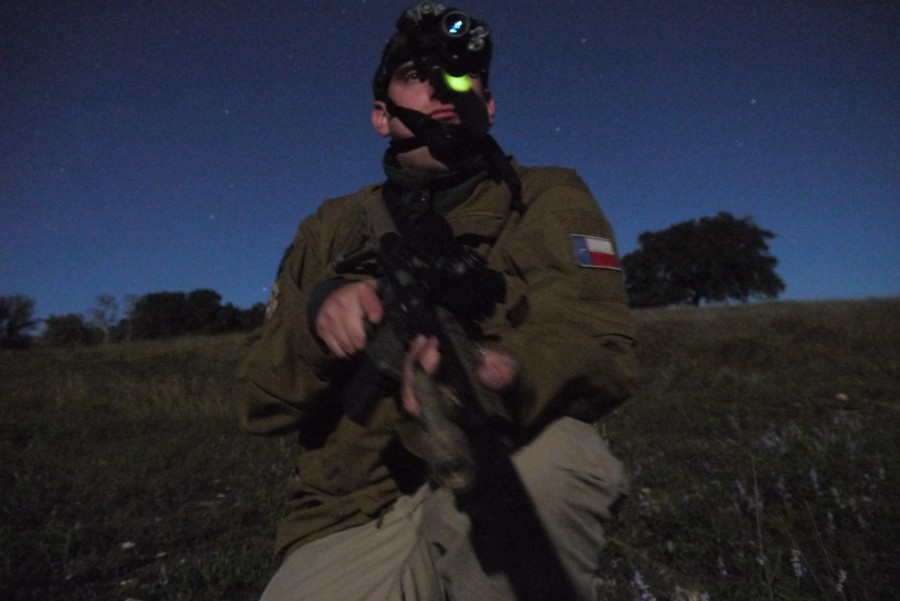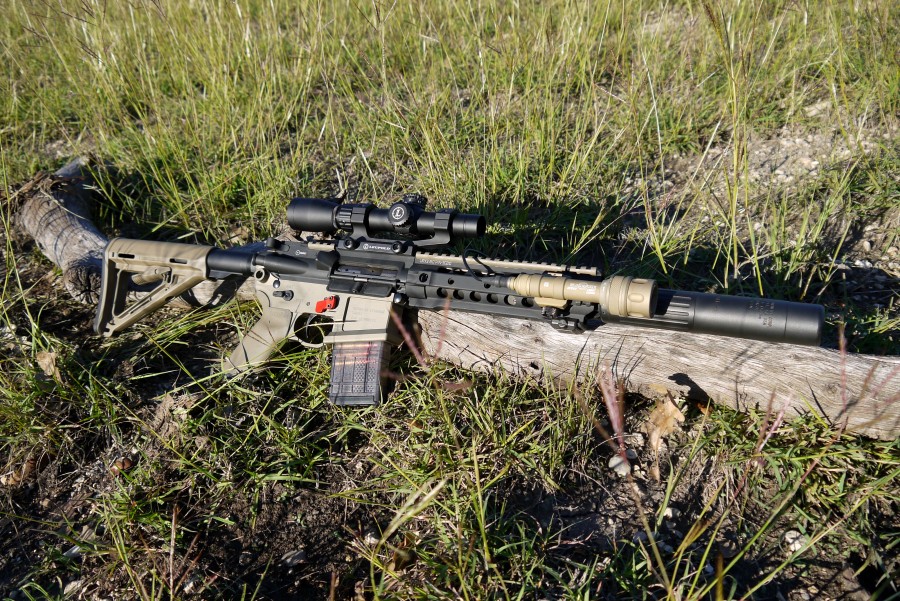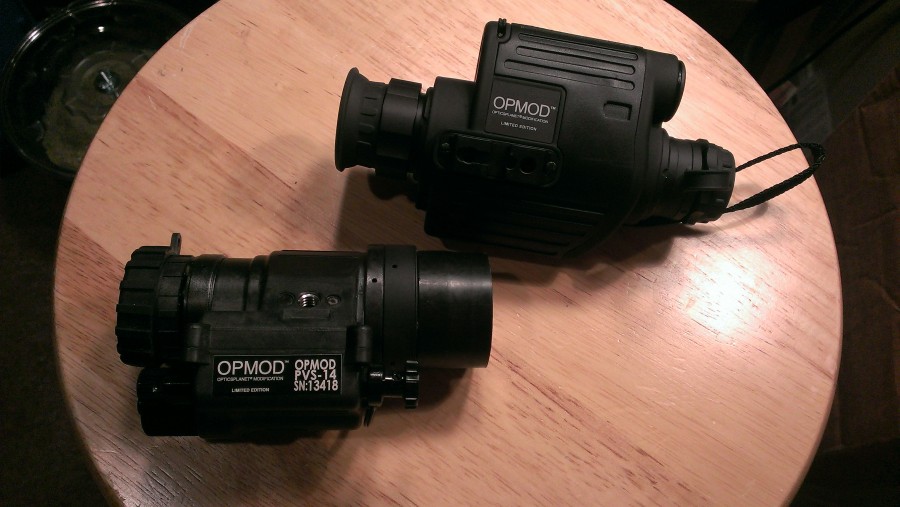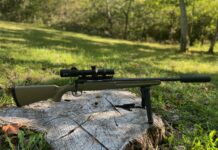Tyler’s mom thought that there might be some critters taking advantage of her pond late at night. The thing was practically overflowing thanks to the recent rains and attracting all sorts of nocturnal visitors. She wanted to find out if a local group of coyotes were using her pond for a clubhouse and I needed an excuse to try out some night vision monoculars that Optics Planet had sent my way. After asking around for a couple other goodies from some of our favorite gear suppliers, I marched out of the warm farmhouse into the cold and dark Texas night to investigate . . .
We as humans are engineered for daylight hunting. That’s what we’ve evolved to do; go hunt and gather during the day and then crawl into a tree and sleep all night. So when we venture into the darkness, we’re entering an environment for which we weren’t designed to operate. We don’t have the natural night vision required to get the job done, which is where technology steps in to help us out.
I had asked Optics Planet to let me try out some of their night vision tech a while back and in order to properly give me a frame of reference for the difference between the generations they sent a Gen 1 scope (which we will be giving away to some lucky reader shortly) and a Gen 3 PVS-14. The Gen 1 device costs about $300, while the state-of-the-art PVS-14 clocks in at $3,000. The guys at Optics Planet said that it wouldn’t take me long to realize why there was such a difference in price and they were absolutely right.
The night I picked to head out and investigate the pond was perfect. There wasn’t a cloud in the sky, a full moon was shining down on the ranch and while the temperature had dropped to a brisk 50 degrees it wasn’t cold enough to keep me away. I’ve experienced plenty of chilly mornings on that ranch, the same place where I’d made my first kills nearly two years ago, and duly learned my lesson.
While 5.11 started me down the path to tacticoolery in my wardrobe, Vertx won my heart. Full disclosure requires me to point out that they’re my sponsors for the year, but after they sent me my complementary two pairs of pants for Team FNH, I loved them so much that I bought four more and one of their pretty awesome looking jackets with my own cash. I’ve worn 5.11 pants every day I was on duty, but Vertx just blows them out of the water.
My feet were similarly kitted out with Danner’s new Rivot TFX Hot Military boots which I was handed at the Crimson Trace Midnight 3-Gun this year and have been wearing ever since. All told, it was the most comfortable I’ve ever felt when I walked out the front door with my rifle and started down the trail to hunt.
It probably won’t surprise you that things look a lot different at night. Distances appear farther and the shadows are darker. Your situational awareness contracts to a bubble of about 10 yards in any direction and every sound you hear seems amplified somehow. As I walked down the limestone road towards the pond, all I could see was the white rock under my feet. The inky shadows on either side were impenetrable without some artificial light, which was thankfully provided by Surefire.
Surefire is another company whose products I’ve been using and trusting in the field since I first set foot in a fire station, and for good reason: they work every damn time and they work perfectly. When I told my guy at Surefire what I was up to with the night vision stuff, he sent me a care package that included a Surefire M600 Ultra Scout Light, as well as a KM2 replacement head that can be set to either a standard white light or infrared light setting (for use with night vision). As I was walking down the road I had the light set to standard white mode, and would occasionally flash a quick beam at any suspicious looking shadows. At that point I was still out of sight of the pond and was more concerned with being ambushed by a pack of hogs than scaring off my quarry.
A few minutes later I’d gone as far as the road would take me. The pond was still about 200 yards away and there was a nice pile of trees halfway there that I was planning on using as concealment while I watched for any midnight visitors. When I reached the pile I set my rifle against one of the logs and started playing with the night vision gear I had for the night. And yeah, there was a clear winner.
The Gen 1 scope worked, there’s no doubt about it. Especially with the built in infrared illuminator, objects within about 20 yards were clearly identified and beyond that you could make out enough shapes to figure out where you were. But even so, it was incredibly dark. I grabbed my rifle and flipped the beam to the infrared setting, but it didn’t make much of a difference — the thing was damn near useless for hunting past 20 yards even with the assist from Surefire and the full moon bathing the pond in photons.
I set the Gen 1 device down and donned the PVS-14. It came with a head mount for just such an occasion so I strapped it onto my head and clipped the PVS-14 into place before flipping the switch, and then it was like I was seeing the world in broad daylight — albeit more green than usual. The features of the pond showed up in vivid monochrome detail, and I could even see the resident horses frolicking in the fields hundreds of yards away.The difference between the two devices couldn’t be clearer. While the parts of the field that were bathed in moonlight showed up well without any additional assistance, the shadows were still a little dark. Thankfully, the IR setting on the Surefire Scout Light threw a very bright beam of IR light their way and lit those areas up.
Using an infrared flashlight is a strange thing. In one eye, you can see that the light is working and casting a beam into the inky shadows. But in the other eye, it doesn’t look like the thing is working. The flashlight doesn’t have any indication that it’s on when in IR mode, so if you didn’t have a night vision device you couldn’t tell the difference. It’s perfect for soldiers who don’t want to give away their position, and equally good for hunters who want to stay concealed while waiting for the critters of the night.
Having your field of view restricted to such a small circle of green light gets a little claustrophobic after a while. I was sitting on that pile of logs for a good hour, all the while I heard coyotes and other nocturnal predators making their presence known, and I kept having to shine my flashlight around to make sure that there were no unexpected guests creeping up on me. Hunting in the daylight I was king, but hunting at night I was blind and vulnerable.
As the hours ticked by, nothing happened. No hogs or coyotes showed up at the pond for a late night drink so I started back up the road empty handed. But despite not having anything to show for the evening except a nifty photograph, it was still plenty fun. And with deer season only two weeks away, I’d be back to try again.








Did you have some sort of IR aiming device on your rifle or do you have a way to co-qitnnes the PVS-14 with your scope?
There are IR compatible lasers out there, but I’m not sure if they are available to consumers.
I’ve seen mounts for sale that allow you to mount a monocular on a railed receiver. You could put an NVG compatible red dot in front of that and have an effective sighting system.
http://www.opticsplanet.com/armasight-night-vision-monocular-advanced-integrated-mount.html
There are also mounts that clamp the NVG to the objective of a scope:
http://www.opticsplanet.com/atn-scope-adapter-mount-nvm14-acmpan14afdt.html
I’m aware of that. I was curious of Mr. Leghorn had any of that set up. I run a PVS-14 behind an EOTech that I can swap out with a 3x magnifier.
There are “civilian legal” IR Lasers out there. They’re classified as “Class 1” IR lasers and are lower power than the ones that the military is using (PEQ-15s and the like). The first one that comes to mind is the Laser Devices DBAL. Crimson Trace is also making Class 1 IR lasergrips for some handguns now too.
http://tnvc.com/shop/category/class1-civilian-legal-infrared-lasers/
The OpMod PVS-14 shipped with a picatinny adapter to do exactly what you describe, but instead I clipped a Crimson trace IR laser to the rail instead and used that. But since I didn’t have a chance to shoot anything, I didn’t mention it this time.
Unsolicited advice; take some time and see if you prefer wearing the NOD’s and using the laser to aim or mounting the PVS-14 inline with your scope. I’d say there are advantages to both, but I prefer mounting the NOD’s on my weapon. I’m curious to see which one you prefer.
Uh, Nick, that PVS 14 you mention is a Gen III device not a Gen IV. No way you can touch Gen IV for $3K.
I know things in America are cheap but a gen 4 for 3k USD? That same optic costs 50k USD in Norway (and people wont sell you one).
They start around $4K here. http://www.atncorp.com/night-vision-monoculars One reason they are so costly in Europe is that they are restricted items here and can’t be legally exported. So, you are either purchasing a smuggled one or one that has jumped through multiple governmental legal hurdles which costs $$$
Geez, two posts in a row of my two favorite shooting hobbies.
I love hunting yodel dogs with NV. I’ve got one on my AR that has a out port for hooking up to a recording device.
Way cool.
You have to keep your head on a swivel when you’re using a monocular NVG. Basically, your FOV is like looking through a toilet paper tube. Also – no depth perception. Ranging becomes interesting. I currently own a night vision scope that has ranging stadia incorporated into the reticle for that reason.
I’ve been using the KM4 white/IR flashlight head for two years. While you can’t see the output with the naked eye, looking at the lens and tilting it a bit this way and that while IR is on should reveal a faint red tint on the bezel that does not appear when the light is off. This tint is not visible at a distance. Perhaps this isn’t true on the KM2?
Shooting coyotes – a valuable predator – for the mortal sin of drinking pond water. Wow. Nice work, assholes.
Coyotes are a vermin. There are too many of them and cause damage.
So is Burke, but we don’t go around shooting him.
Even “valuable predators” can become pests in sufficient numbers. Hunting, aside from gathering food, is also about managing the balance between that food and the predators (including us).
Three pests that would survive a nuclear exchange:
1. Cockroaches.
2. Pocket gophers.
3. Coyotes.
I’m perfectly happy to be rid of any of them.
Billy, Billy, Billy.
http://www.mercurynews.com/science/ci_24328026/coyotes-attack-colorado-man-walking-work
And if you have livestock, like sheep? A dead sheep might get shorn once. Post mortem.
Ever try to shave a coyote and make a sweater?
The coyote attack story doesn’t prove anything except that such incidents are vanishingly rare–especially considering the ubiquity of these nocturnal canines. If you’ve hunted coyotes, you know how good they are at avoiding contact with humans.
You’re in far more danger from domestic dogs gone bad.
That said, to each his own. Keeping coyotes away from vulnerable livestock is one thing, hunting them for challenge and sport is another, and though I wouldn’t do the latter, it isn’t necessarily wrong. Just be honest about your reasons.
The Surefire package is nice, but for those of us who are not likely to be gifted a $400 flashlight and $300 IR replacement head by Surefire, I’m wondering if there are some decent alternatives for less. The Streamlight SuperTac IR illuminator? I can find it on Amazon, but not on Streamlight’s site for some reason.
Streamlight SuperTac IR
http://www.streamlight.com/Static/Document/Info_Sheet_with_Part_Numbers/supertac-ir_sup.pdf
Pretty high test Fire Dept if they can afford Surefire lights.
shameless self plug.
http://www.youtube.com/watch?v=F9IIV2iyDUc
“Cold Texas night…”
What do Texans know about cold, exactly? 😉
You should learn to use a call, and mind your scent.
Coyotes aren’t difficult to hunt. Put up the right wounded prey call for your area and you’ll bring them running.
We are still wearing shoot sleeve shirts and sandals at 50F.
while the temperature had dropped to a brisk 50 degrees it wasn’t cold enough to keep me away.
I’m from Wisconsin and am having trouble understanding your writing.
Using the term “brisk” means that it is cold.
50 degrees should be referred to balmy.
50 degrees never presents a threat to any activity other than swimming.
Bear in mind that not a week before, nighttime temperatures “dipped” into the high seventies…
In Florida we put on parkas and start layering clothes when the temp drops below 60 degrees. Balmy in the south means 85+ with 100% humidity. People from up north would drop dead in the streets on a normal summer day here, likewise I would most likely drop dead from hypothermia on a mild Wisconsin winter day. People adjust to climates I guess…when I visit my family in Upstate NY and NH they laugh at how miserable I find the freezing temperatures.
Oh, the humanity…and the humidity… I’d die in Florida or Texas. Being a native of the desert/mountain west, I’m no stranger to either hot summers or cold winters, but humidity where I grew up routinely hovers in the low teens. Single digits, even.
Cold is relative. Give me a light jacket or a warm shirt, and I’d be good to go all night at 50 degrees. It does bite a lot harder when you can’t move around, that’s for sure.
The difference between Gen I and Gen III is like night and day.
The IR may not be visible to your eye, but it is visible to your iPhone or other digital camera. Soldiers who rely on that for stealthiness are kidding themselves. For animals other than birds it’s probably fine, but for people with some savvy you should stay passive and not use IR beams. I don’t know why the military uses them.
Nick, you obviously haven’t been paying attention- ranches in Texas don’t have “ponds” (I always hear that word in a mincing, poofterish voice)- they have “TANKS* (that, of course, comes in a manly voice). Ya gotta call stuff by the right name if you want to be understood! 🙂
I guess things is different everywhere. In the Mountain West states, a pond is a pond, and a tank is a storage container (or a military vehicle).
I grew up near a highly visited national park, and we always scoffed at the European tourists and clueless Easterners who drove by and asked if they could take a dip in our “swimming hole” or “reservoir.” Mincing, poofterish voice optional; calling a working irrigation pond a swimming hole poofterizes you regardless. The Europeans get a pass, but Americans ought to know, dag nab it.
Depends on which part of Texas you are in. Where I live, in east Texas, they are called ponds. In west Texas they are tanks. Some friends and I from college argued this one constantly. Every time he talked about fishing in his tank I had a mental image of a fishing pole in an aquarium.
Too many commercials 🙁
I have been a hunter and shooter for over 20 years.
Why any self respecting hunter would bother to kill coyotes is beyond me.
Unless you are truly a farmer with livestock at risk, or you live so remotely that you honesty fear for your children’s lives…It is just more lame ass trophy hunting.
Apparently these beasts were ” taking advantage of her pond late at night”..
God Forbid!! Holy Shiza!! Bust out the BDU’s and the tactical boots!
Whatever…
If you have any working dogs or pets coyotes are a clear and present danger to them.
The veternarian bills from a bird dog and coyote encounter made a friend of mine far less tolerant of coyotes. Similarily, an animal loving friend turned the same way after seeing her pet cat for the last time in the jaws of a coyote as it loped off into the desert.
I am a hunter, but anyone who hunts something that I don’t is wrong…..
Kidding aside, if you don’t know what you are talking about, stay out of the conversation. We bought some chickens one time for eggs. Within a month everyone was gone. Last year a friend gave my two kids a pair of kittens. they lasted about 2 weeks. Lost a calf 3 years ago to yotes. I kill every damn one of em I see. Between my PVS/14, thermal scope, and electronic predator call, they are fairly easy to bring in and eliminate.
Comments are closed.